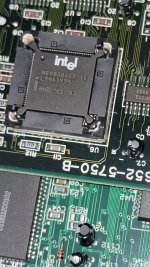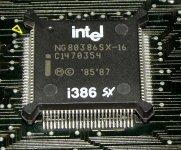Hello,
I have a pretty simple question. Is there a way, if any, to pop this processor out of this socket? It seems as if there would be a way, but I'm not sure. I can get a better sideview of the processor socket tomorrow if this picture does not suffice.
The reason I ask is because I'd like to replace it with one of those Cyrix "486" 386 processors (or the TI variant of said processor). However, it may not be possible, given the shape of the processor with those nubs (for lack of a better term) jutting out on each corner. I don't know what those would be for, given that I am a bit of a layman on processor design minutiae from the time.
The ultimate reason for the replacement is that I'd like to run Windows 95. I get that this is probably a suboptimal platform, but it's what I have.
I appreciate your help in advance,
Forrest
I have a pretty simple question. Is there a way, if any, to pop this processor out of this socket? It seems as if there would be a way, but I'm not sure. I can get a better sideview of the processor socket tomorrow if this picture does not suffice.

The reason I ask is because I'd like to replace it with one of those Cyrix "486" 386 processors (or the TI variant of said processor). However, it may not be possible, given the shape of the processor with those nubs (for lack of a better term) jutting out on each corner. I don't know what those would be for, given that I am a bit of a layman on processor design minutiae from the time.
The ultimate reason for the replacement is that I'd like to run Windows 95. I get that this is probably a suboptimal platform, but it's what I have.
I appreciate your help in advance,
Forrest


